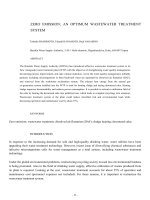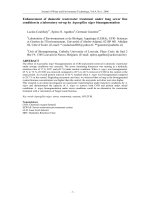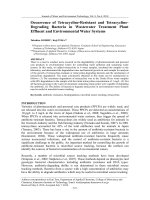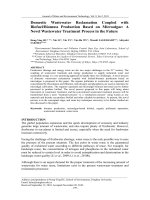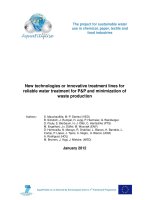Wastewater treatment: 2nd sample questions and discussion
Bạn đang xem bản rút gọn của tài liệu. Xem và tải ngay bản đầy đủ của tài liệu tại đây (335.27 KB, 8 trang )
Final Exam (continue)
Topics covered:
(Water hydrology)
through
(Chlorination)
Including:
Hydrology
(Ch 4, section 4-1)
Water Pressure and relationship with height
Open channel flow
(Ch 4, sections 4-8)
Manning’s equation
Flow measurement in open channels
(Ch 4, sections 4-10)
Parshall flumes
V-notch weirs
Groundwater Hydrology
(Ch 4, sections 4-14)
Soil porosity and subsurface flow
Darcy’s law
Hydraulic conductivity
Aquifers (unconfined, confined)
Well hydraulics
Calculation of well discharge
Calculation of permeability (pumping tests)
1
Types and sources of water pollution
Water quality regulations
Clean water act
(Ch 5, section 5-4)
NPDES
(Ch 5, section 5-4)
SPCC
Safe Drinking water act (Ch 5, section 5-1)
Primary standards
Secondary standards
MCLG, MCL
SWTR
Groundwater protection (Ch 5, section 5-7)
Drinking water treatment
Treatments for surface water and groundwater
Treatment reactors
Rapid mix reactors
Plug flow reactors
(Ch 7, section 7-2)
Flocculation
(Ch 7, section 7-8)
Coagulation
Paddle flocculators
2
Sedimentation
(CH 7; section 7-3)
Settling velocity
Overflow rate (surface loading rate)
Filtration
(Ch 7; section 7-7)
Mechanisms of filtration
Pressure filters
Slow sand filters
Rapid sand filters
Filter backwashing and surface washing
Filter media
Dual and multi-media filters
Chlorination and disinfection
(Ch 7; section 7-12)
Chlorine chemistry
Free chlorine residual
Ammonia removal
Breakpoint chlorination
Disinfection of surface and groundwater
The “C.t” concept of disinfection
Temperature and pH effects
Primary and secondary disinfection
Different disinfectants
Tri-halo methane (THM) formation
3
A) TRUE / FALSE (If false, explain briefly)
The primary objective of a drinking water treatment plant is to remove
soluble BOD. F
Giardia cysts are generally more resistant to chlorination than are
bacteria.
T
Free chlorine residuals represent the sum of HOCl and chloramine
concentrations. F
During water treatment, a coagulant is typically added between
sedimentation and filtration. F
The rate at which a particle settles in water is a function of its size. T
The form of chlorine that predominates at pH = 9, is dissolved chlorine
gas. F
Ozone is a disinfectant that forms long-lasting secondary disinfection
residual. F
4
An overflow rate, e.g. gpm/ft2, can not be expressed in units of velocity. F
For a plug flow reactor, the detention time is a function of the length of
the reactor.
T
During flocculation, the size of the floc increases due to quick mixing. F
The unit of porosity is gpd/ft2. F
The piezometric surface in an unconfined aquifer is commonly below
the water table. F
Secondary treatment of domestic wastewater has been made
mandatory by the clean water act. F
According to the SDWA, maximum contaminant level goal is an
enforceable standard which must be achieved by the treatment plants. F
Direct filtration (without sedimentation) increases the filtration rate.
F
5
B) Short answer questions
Relative to drinking water treatment, give examples of contaminants that
commonly have to be removed from:
a) Surface water sources (name 3 contaminants)
b) Groundwater sources (name 2 contaminants)
Briefly describe how a rapid sand filter is backwashed.
During breakpoint chlorination, what materials consume the added free
chlorine?
How ammonia is removed from water using chlorination?
What are the components of the ground water protection plan under SDWA?
What measures can be taken to prevent the formation of THMs during the
disinfection process?
Why groundwater is not disinfected for Giardia cysts?
6
C) Numerical Problems
1) The settling velocity of an alum floc is approximately 0.0014 ft/s
in water at 10 0C. What is the minimum detention time (in hours)
to settle out this alum floc in an ideal clarifier with a depth of 10 ft?
td= L/v= 10/0.0014=7142.86 s = 1.98 h
(td )
2) Two rectangular clarifiers each 27 m long, 5.0 m wide, and 3.8 m
deep settle 6000 m3/d of water. Calculate the detention time and
overflow rate.
V=1026 m3
td= V/Q=0.171d=4.104h
v0=Q/A1=6000/270=22.2m/d
3) What is the major advantage of a dual-media coal-sand filter
compared to a conventional plain sand filter?
4) Why chlorination has to be preceded by chemical coagulation
followed by granular-media filtration for effective disinfection of
surface waters?
7
Some comments……..
** BRING CALCULATORS
** Manage time well during exam……try to
answer all the questions
** Always pay attention to units
8
